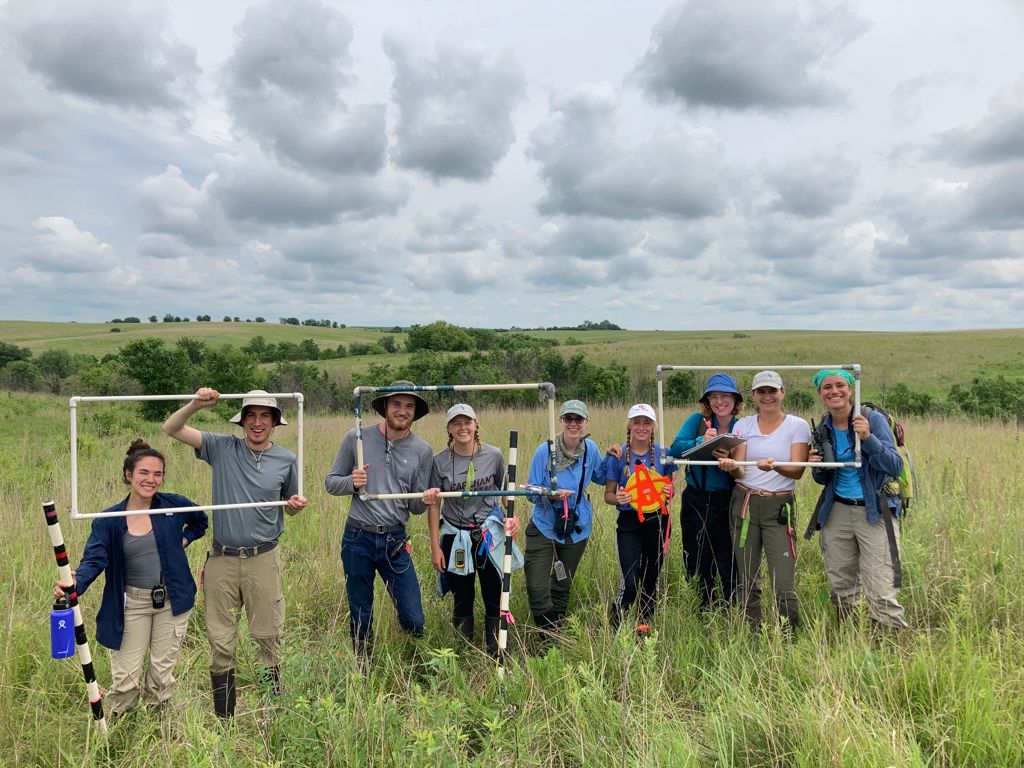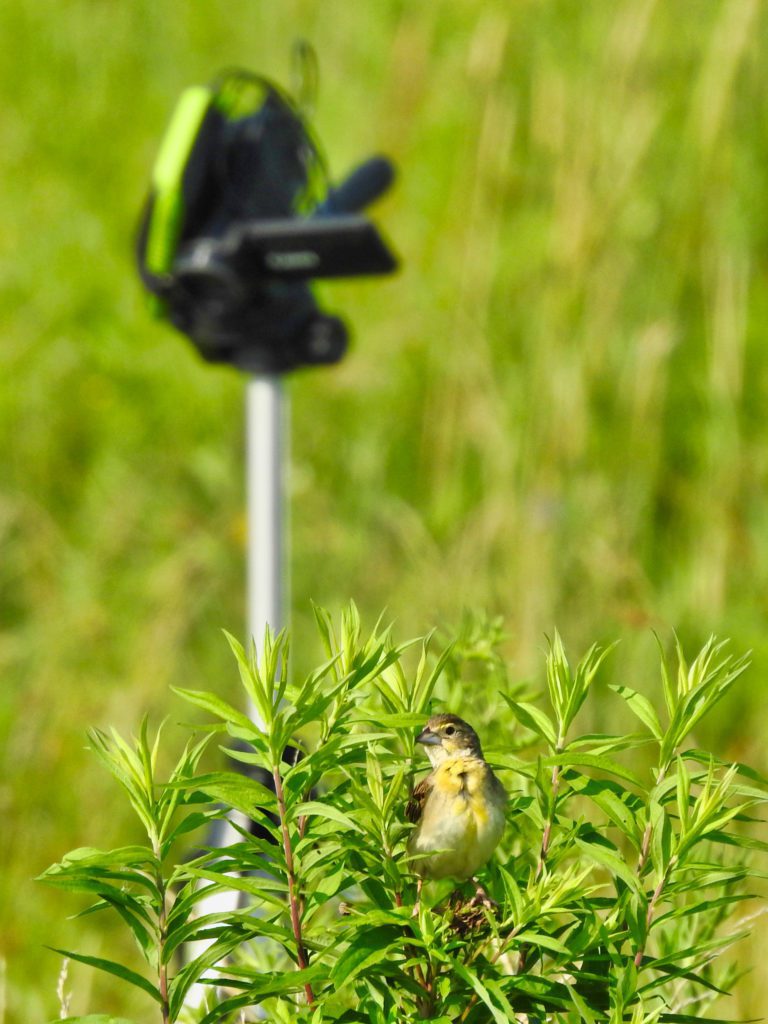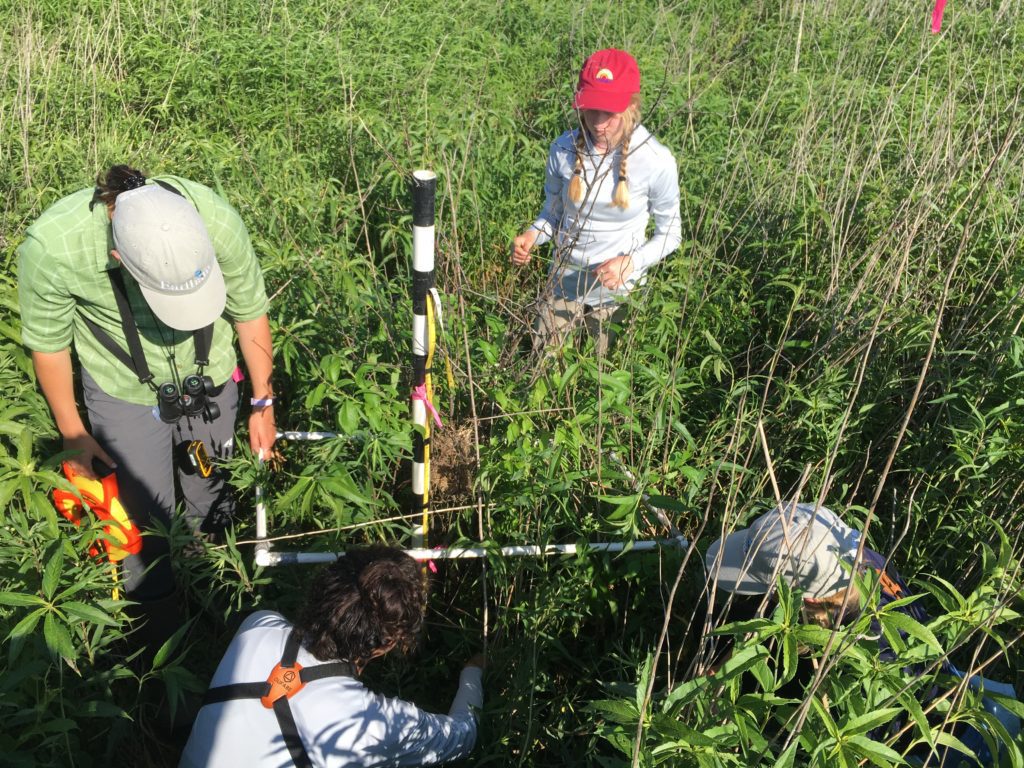
Wildlife ecologists from Earlham College are investigating ways to restore the tall grass prairie, a now declining ecosystem that once sustained an abundance of grassland birds across the Great Plains and Midwest, including Indiana.
Earlham professors Jaime Coon and Wendy Tori travelled with a team of Earlham students this summer to the Grand River Grasslands in southern Iowa, home to some of the last remaining tallgrass prairies in the United States. For seven weeks, they collected data, recorded nesting behaviors and assessed native plant communities in these highly threatened ecosystems. The project is continuing this fall on campus, and could offer clues for how to strengthen existing grasslands and rebuild habitats closer to Earlham
“We have lost about 90 percent of original tallgrass prairie, so it is not surprising that grassland birds are one of the fastest declining avian group in North America,” said Coon, a visiting assistant professor of biology and environmental sustainability. Coon got involved with the project in 2014 while earning her Ph.D. from the University of Illinois Champaign-Urbana.

“Diverse bird and plant communities can be a reflection of how healthy an ecosystem is and so it is critical to examine factors that could be contributing to these declines. We want to maintain the grassland populations we have left and restore functionality to grasslands that have been degraded,” she notes.
The project is a part of an ongoing collaboration between Earlham and the Iowa Department of Natural Resources, private landowners and researchers from the University of Illinois Champaign-Urbana.
“This is an extraordinary opportunity for our students interested in field ecology. There are not many places you can go where there are relatively large expanses of tallgrass prairie in the United States and experimental management strategies already in place,” said Tori, who is Earlham’s Martha Sykes Endowed Chair for Biology in Ornithology. “Conservation cannot only rely on state parks because those are only tiny islands. The only way to be successful is to bring private owners into the conservation effort. I think this long-term project in southern Iowa has the right vision, all stakeholders working together towards a common goal.”
Earlham students with a demonstrated interest in animal ecology and conservation were invited to apply. Five biology or environmental sustainability students—seniors Joshua Angell, Thea Clarkberg, Claudette Roskamp, Ethan King and junior Hannah Grushon—were supported by Earlham’s Summer Collaborative Research program and the Department of Biology’s endowed funds. Earlham senior Molly McKellar also received an internship from collaborator Jessica Mingione, a master’s student working for the University of Illinois.
“I really enjoyed working with everyone on our team,” said Angell, a biology major from Havertown, Pennsylvania. “I love being outside with nature and birds, especially in these spectacular habitats that are so different from everything I’ve been around in my whole life.
“The biggest benefit is being able to say, ‘I already know how to do avian transect surveys, I have performed vegetation work, I already have experience working in the field,’” he said. “That says a lot to future employers.”
Parasite bullies, predators and other perils
Grassland birds are facing many threats in their tallgrass prairie habitats, including habitat loss to agriculture, increasing prevalence of invasive plants, and even other birds with unusual parenting techniques. That’s bad news for the meadowlarks, sparrows and bobolinks that frequent Iowa’s last remaining prairies.
Tall fescue, an invasive perennial grass, is a known problem in the Iowa prairies and across the Midwest. Its prevalence is believed by researchers to choke out native prairie plants and increase the likelihood of bird eggs or nestlings being eaten by snakes or other predators.
Healthy ecosystems have a diversity of plants, birds and arthropods, like ants, spiders and other insects, Coon notes. “When you only have one species, such as a grassland taken over by tall fescue, the ecosystem can be less resilient to change, which can drastically affect native populations and reduce ecosystem services grasslands provide to humans, such as cattle production, flood control, pollination, cultural connections to nature and more,” she said.
The unusual reproductive strategy of brown-headed cowbirds is another potential threat to grassland birds. These birds are notorious for laying their eggs in other nests, leaving the host birds to raise their young. Scientists call this “nest parasitism,” and there is evidence that human actions, such as habitat destruction and increasing prevalence of invasive plants, might be increasing the abundance of these sneaky birds.
“Everyone knows that raising childrentakes a lot of effort,” Tori said. “But if birds dump their eggs in another nest and don’t use their energy on raising their own offspring, they can potentially produce a lot of more eggs. It’s a super cool reproductive strategy but it could be having a negative effect on birds that are already not doing well.”
The Iowa DNR is implementing several land management strategies on private-owned land and protected lands. “Our sites have different treatments consisting of grazing, invasive species control, and controlled burning.These are treatments that the collaborative Grand River Grassland research team has been tracking for over a decade,” Coon explains. “For instance, if we control the fescue, does it have an impact on these grasslands birds? Does it influence nest parasites or feeding behaviors? These are some of the questions we’re trying to get answers to.”
The team is also conducting an analysis this fall of an avian oddity known as “dipping,” or a process by which parent birds insert food in and out of their chicks’ mouths before letting it go.
“We have no idea what the function of this behavior is, so students generated some hypotheses to test,” Coon said. “Is it a way for parents to assess whether the nestling is hungry? Is it used to determine whether the nestling is a brown headed cowbird or one of their own young? It’s such a cool thing to be able to describe new behaviors in the scientific literature.”
Up before sunrise ready to work
Field research is not for the faint of heart, but for those with an adventuresome spirit who are ready to work hard. The days can be long, and often begin just before sunrise, the optimal time to observe birds singing and protecting their nests.
“Being in the field takes some passion and motivation and grit,” said Coon. “You are working in the heat, in the rain and must be ready to walk long miles. But it’s also so incredibly rewarding. In addition to testing hypotheses and creating new knowledge, you get to see the sunrise every morning, stroll through fields of wildflowers, and get to know native bird species on a very personal, deep level. There’s nothing like it.”
Searching for and monitoring bird nests requires patience and ingenuity. In addition to the binoculars and camera equipment needed to locate and record bird activity, the team constructed a 60-foot long “nest rope” that can quickly scan the terrain in search of nests buried deep in the tall grass. Empty aluminum cans are tied to the rope, which produces a noise that startles the birds that might be lurking out of sight of the researchers.

“The birds will shoot up into the air when the rope gets close to them,” Angell said. “Then you will go and check that spot to see if there’s a nest there.”
Each day of the project, the team would conduct bird surveys, search for nests, and set up cameras to record parental and nestling behavior. The team would finish each day with an assessment of vegetation structure and composition near nests. On rainy days, the group would watch the videos they recorded in the field to code parental behaviors at the nest.
“It’s not glamorous, but that doesn’t mean it’s not fun and exciting,” Angell said. “You would sometimes find ticks on your clothes. We were proactive about it though. We would tuck our pants into our socks and tuck our shirt into our pants.”
During this experience students had the opportunity to immerse themselves in the scientific process, from learning how to ask relevant questions, generate testable hypotheses and predictions, how to design and conduct a field study, collect and analyze data, and ultimately how to share the results with the scientific community.
“This opportunity has really helped me better understand what I want to do after Earlham,” said Thea Clarkberg, a senior biology major from Ithaca, New York. “I originally thought I wanted to be veterinarian, but after taking classes on conservation and biology, and conducting biological research in the field, I’ve changed my thinking. This experience really solidified that.
“Wendy and Jaime are also just really cool,” she said. “They are my kind of people. Working on a team and working outside with them, all of those technical skills we’ve learned will transfer to any kind of research that I do in the future.”


Earlham’s fascination with birds
Birding and ornithological research both have been popular on Earlham’s campus for decades. Birding Big Day, an Earlham tradition spanning more than four decades, is a bird-a-thon and fundraiser for the Earlham Fund, which helps provide scholarships to make an Earlham education accessible to future generations of students.
Related link: Earlham Birders Facebook group
Budding field scientists from Earlham have also traveled the world to study bird behavior and habitats. In addition to the project in Iowa, Tori has taken students to Tanzania, the Amazon Rainforest, Galapagos Islands, Papua New Guinea, Ecuador and Borneo, among other locations.
Now that the field research in southern Iowa is complete, the team is busy analyzing the data they collected and will co-author a report to inform the Iowa DNR on the most effective strategies for enhancing the remaining grasslands. The project should also result in a report published in a peer-reviewed, scientific journal.
“What’s so exciting about this is we might actually affect management strategies to help with the conservation of these species,” Angell said.
“Students at bigger institutions don’t necessarily have these same opportunities,” Clarkberg said. “There are so many students and not enough faculty to take people into the field. Not only do we get to do research like this and take classes with these professors, but we got to spend more than a month in the field and are working on publishing a paper. That’s really rare for undergrads.”
The results of the research are likely to have further relevance close to home. Coon is working with Dan Atwater, an assistant professor biology at Earlham, and Jamey Pavey, the director of Earlham’s Center for Environmental Leadership, to grow new prairie habitats on campus, potentially attracting new bird sightings on campus. The project was started in 2019 by a team of environmental sustainability students as part of a senior capstone project, led byPavey and Karen Mager, a former Earlham professor now working at Southern Oregon University.
“What we are learning in the Grand River Grasslands is highly relevant to prairie restorations close to home,” Coon said. “The plants we are putting into our new Earlham prairies are largely the same as those planted in our Iowa restorations. We’ve found bobolinks, savannah sparrows, and eastern meadowlarks on Earlham’s back campus, all declining grassland birds that could benefit from these restorations right here at home.”
Research experiences like these demonstrate the transformative power of an Earlham education and the College’s commitment to making the world a better place to live, Tori said.
“Our students are very motivated to fully immerse themselves and use the knowledge they have learned to solve real world questions and make a difference,” she said.
Media contact
Brian Zimmerman
Director of media relations
Email: [email protected]
Phone: 765.983.1256